
…die Kleinanzeigen wären dann auch durchgespielt!?
[via]
There has been a huge spike of creativity because of the COVID-19 quarantine. People come up with amazing ideas when they’re bored. First there were Famous Painting Recreations, then Australians Dressed Up For Taking Out Trash. Now people all around the world have started to reenact famous movie scenes using only the stuff they can find at home.




















“I decided to come to the U.S. to save my life,” says Luz, a transgender asylum seeker, in Sylvia Johnson’s short documentary Luz’s Story. In Honduras, Luz was shot multiple times by alleged gang members who targeted her for her trans identity. She barely emerged with her life. As soon as she was released from the hospital, she was transferred to a Honduran prison on charges of defending her identity. Upon her release 10 months later, after being abused in prison, several gang members again threatened her life.
Luz entered the United States via an official port of entry and asked for protection through political asylum. She was promptly imprisoned. “I had already been imprisoned [in Honduras] and didn’t want to experience another situation like what I had been through,” she says in the film.
Later, Luz would learn that her Immigration and Customs Enforcement detention facility, New Mexico’s Cibola County Correctional Center, had previously been a criminal correctional prison. In October 2016, it was shut down due to inhumane conditions that resulted in several inmate deaths. Shortly thereafter, ICE offered a contract of $30 million a year to the same facility. It reopened in January 2017. Since early 2018, Cibola has incarcerated more than 180 women in its “transgender pod”—the only known ICE-run detention facility for transgender-identifying women. According to Johnson, the incarcerated women, such as Luz, were seeking protection from violence and persecution they had suffered in their home country.
Luz says she spent three excruciating months in Cibola—two of which were in solitary confinement. “It was really, really horrible for me,” she says. “I went into a depression that made me want to hurt myself.”
Johnson, who works part-time at the Santa Fe Dreamers Project, told me that the women in the trans pod face extraordinary hardships and obstacles to winning their cases. “While in custody, they face a shocking lack of medical and mental-health services,” she said. “They are put in abusive solitary confinement, they experience high levels of sexual assault, and they face discrimination from the government and the corporation that detains them.” Johnson cited the deaths of Roxsana Hernandez Rodriguez in 2018 and Johana Medina Leon this year as grave evidence of ICE’s inability to detain trans women safely.
Luz’s Story, a collaboration between Johnson and the photographer Eduardo Montes-Bradley, is just one horrific account of the trauma experienced by many trans asylum seekers.
“I was completely blown away by the resilience of Luz’s spirit and how vivacious she is despite what she has gone through,” Johnson said. “Luz has been through things that no human being should ever have to experience, and she is warm, kind, full of life, and unafraid to speak her truth.”
Just over a decade ago, Matt Eich started photographing rural Ohio. Largely inhabited by what is now known as the “Forgotten Class” of white, blue-collar workers, Eich found himself drawn to the proud but economically abandoned small towns of Appalachia. Thanks to grants from the Economic Hardship Reporting Project and Getty Images, Eich was able to capture the family life, drug abuse, poverty, and listlessness of these communities. “Long before Trump was a player on the political scene, long before he was a Republican, these people existed and these problems existed,” Eich said. His new book, Carry Me Ohio, published by Sturm and Drang, is a collection of these images and the first of four books he plans to publish as part of The Invisible Yoke, a photographic meditation on the American condition. Even with a deep knowledge of the region, Eich was unprepared for the fury and energy that surrounded the election this year. “The anger is overpowering,” he said. “I knew what was going on, and I’m still surprised. I should have listened to the pictures.”

In dieser Woche gab es wieder ein kleines Update für die Google Fit-App, das diese auf die Version 1.61 bringt. An der Oberfläche gab es keine sichtbaren Veränderungen, dafür aber sehr wohl unter der Haube: AndroidPolice hat die App auseinander genommen und gleich eine ganze Reihe von Hinweisen für neue Funktionen gefunden, mit der die App noch mehr Möglichkeiten zum Tracking von Aktivitäten bekommt. Außerdem gibt es ein neues rundes Icon.
Mittlerweile haben alle wichtigen Google-Apps auch eine runde Version des Icons für die einheitliche Optik im Pixel Launcher bekommen, doch Fit war bisher noch nicht unter den Kandidaten. Mit der neuen Version wurde das Icon zwar nun integriert, allerdings ist es innerhalb der App nicht als rundes Icon registriert, so dass es kein Launcher anzeigen kann. Zwar dürfte das Icon der Grund für das ausgerollte Update gewesen sein, in der jetzigen Form macht es aber keinen Sinn.
Das Icon ändert sich nur dahingehend, dass dieses jetzt auf einem runden weißen Kreis platziert wird und so eine runde Optik bekommt. Außerdem gibt es auch noch drei weitere Icons mit den verschiedenen internen Versionen der App. Neben der bereit bekannten Dogfood-Version gibt es intern offenbar auch eine Fishfood und eine Bugfood-Version – da man als normaler Nutzer an diese nicht herankommt, ist dies aber nicht weiter von Belang.
Je nach Körpergröße und Gewicht sollte jeder Mensch am Tag durchschnittlich zwei Liter Flüssigkeit zu sich nehmen – und am besten sollte es sich dabei um Wasser handeln. Für Sportler gilt natürlich ein höherer Wert, denn sie verbrauchen durch ihre Aktivitäten noch mehr Flüssigkeit und müssen teilweise die doppelte Menge trinken. Jetzt lässt sich mit Fit auch sehr genau tracken, wann und wie viel Wasser man zu sich genommen hat.
Man kann entweder bei jeder getrunkenen Flasche bzw. Glas einen neuen Eintrag vornehmen, der sich bis auf den Milliliter herunterbrechen lässt, oder auch am Ende des Tages gesamt angeben wie viel man getrunken hat. Einen assistierenden Hinweis dass man nun bald wieder etwas trinken sollte gibt es (derzeit) allerdings noch nicht – obwohl dies gerade für angehende Sportler vielleicht gar nicht schlecht wäre.
Es gibt auch wieder eine ganze Reihe neuer Aktivitäten die man mit Fit tracken und manuell in die Liste der sportlichen Betätigungen eintragen kann: So gibt es nun auch den neuen Eintrag „Klettern“ und nicht weniger als 51 neue Aktivitäten im Bereich der Gymnastik. Da sich diese Aktivitäten nicht automatisch tracken lassen, muss der Nutzer diese manuell eintragen und dort den Zeitraum und den Kalorienverbrauch bestimmen. Eine automatische Bestimmung wäre nur durch viele weitere Sensoren und Geräte möglich, aber eben nicht durch das Smartphone.
Automatisch erkannte Aktivitäten bestätigen
Fit kann einige Aktivitäten automatisch erkennen und tracken, ohne dass der Nutzer etwas dazu beitragen muss. Das funktioniert zwar nur für sehr wenige Aktivitäten wie dem Spazieren, Joggen oder Fahrrad fahren, aber kann natürlich auch viele False-Positives erzeugen und die Datenbank des Nutzers mit falschen Einträgen füllen. In Zukunft wird Fit den Nutzer bei Unklarheiten auch mal per Benachrichtigung fragen ob es korrekt erkannt worden ist oder nicht. Wird die Anfrage nicht bestätigt, wird die Aktivität auch nicht eingetragen.
Schon jetzt sind alle Daten von Fit in der Cloud gespeichert und werden über alle Geräte und Plattformen hinweg synchronisiert. Das galt bisher allerdings nicht für die App und die Einstellungen selbst, die nach einer Neuinstallation verschwunden waren. Auch dies wird mit der neuen Version aktiviert und dann über die Cloud-Speicher von Google abgewickelt.
—
Da all diese Funktionen derzeit noch nicht freigeschaltet sind und sich noch in der Entwicklung befinden, muss man sich nicht zu sehr auf das Update über den Play Store freuen. Wer es dennoch schon vorher bekommen oder sich selbst auf die Suche nach neuen Funktionen machen möchte, kann sich die Version 1.61.11 auch direkt bei APK Mirror herunterladen.

A Chinese woman visiting Vietnam over the weekend realised the border official letting her through had scribbled "f**k you" on two pages of her passport, Chinese papers are reporting.
He wrote it right across a controversial map printed on the two pages. The map, which China started printing on three pages in each passport since 2012, is a source of much anger against China in Southeast Asia, because it outlines a large chunk of the South China Sea that China says belongs to it.

Image: people's daily

Image: PEOPLE'S DAILY Read more...

Raise your paw if you are PUMPED for the holiday season.
Cats are not exactly famous for their holiday spirit, but it seems that even the grumpiest of critters is not immune to a little Christmas cheer in 2015. Perhaps these cats are just sucking up to Santa Paws for extra catnip in their stockings, or maybe felines have had a true change of heart. Either way, we should all take a tip from these cats that are dominating the Christmas game right meow.
SEE ALSO: Kind dog-lover knits cheery holiday sweaters for homeless pups
Be inspired by the Christmas kitties below, and meowy holidays to you and yours. Read more...

I recently had a conversation that challenged what I thought I knew about the controversial ritual known as “female genital cutting,” or, more commonly, "female genital mutilation."
FGC, as it is abbreviated, involves an elder or other community member slicing off all or part of a woman’s clitoris and labia as part of a ceremony that is often conducted around the time that the woman reaches puberty. Many international groups are concerned about FGC, which is practiced extensively in parts of Africa and the Middle East and is linked to infections, infertility, and childbirth complications.
Organizations such as the United Nations have campaigned against the practice, calling for its abolition as a matter of global health and human rights. But despite a decades-old movement against it, FGC rates in some countries haven't budged. While younger women are increasingly going uncut in countries such as Nigeria and the Central African Republic, according to a survey by the Population Reference Bureau, in Egypt more than 80 percent of teenagers still undergo the procedure.
So what can foreign activists—as well as locals who oppose female genital cutting—do to curb the practice? For starters, Bettina Shell-Duncan, an anthropology professor at the University of Washington who has been studying the practice in many countries for years, suggests using the term “cutting” rather than “mutilation,” which sounds derogatory and can complicate conversations with those who practice FGC.
She also challenges some common misconceptions around FGC, like the belief that it is forced on women by men. In fact, elderly women often do the most to perpetuate the custom. I thought African girls were held down and butchered against their will, but some of them voluntarily and joyfully partake in the ritual. I thought communities would surely abandon the practice once they learned of its negative health consequences. And yet, in Shell-Duncan's experience, most people who practice FGC recognize its costs—they just think the benefits outweigh them.
Shell-Duncan recently joined a five-year research project, led by the Population Council, whose goal is reducing female genital cutting by at least 30 percent across 10 countries over five years. I spoke with her about how activists, policymakers, and everyday people can better understand FGC so that they can avoid alienating the communities they aim to help.
An edited and condensed transcript of our conversation follows.
Olga Khazan: How did you get into this topic?
Bettina Shell-Duncan: In 1996 I went to Kenya—northern Kenya among an ethnic group called the Rendille. I was doing research on anemia, iron deficiency. I started asking questions about what people in the community perceived were the major health problems. I talked to men and women throughout the community, and they listed a whole host of things: malaria, men talked a lot about diseases in their animals.
People started saying, “We don’t have enough antibiotics for our weddings.”
I was so confused, like, what does that mean? I couldn’t understand what they were talking about. And they pulled me aside and said, “You know, we’re talking about circumcision.”
I said, “I know what circumcision is. I’ve had my son circumcised.”
And they said, “No, we mean for our girls.”
I was completely confused. And they realized that not only had I gotten married without being circumcised, but that I had obviously delivered children without being circumcised, which in their culture was unthinkable.
These women were my very good friends, and they were covering up their faces to not show how repulsed they were by the idea of somebody being uncircumcised and delivering a baby. They were, you know, revolted.
Khazan: Well, wait, what did you say? Because I could imagine—and this is probably why I’m not an anthropologist—but I could imagine myself saying something untoward in that moment, like, “What do you mean? What I’m doing is fine! ... What are you doing?”
Shell-Duncan: On the other hand, these are women who live in a drought-prone region of Africa. Living in circumstances that are so dire. And they’re smart. They know how to cope in those circumstances. And honestly, I have a Ph.D. Would I know how to raise a kid under those kinds of conditions?
Khazan: So when they say that they don’t have enough antibiotics for the wedding, is it because they would do the cutting at the wedding?
Shell-Duncan: Different ethnic groups do it differently. Among the Rendille, they do it as part of the first part of the ceremony. The wedding ceremony spans years.
There’s the time where the bride is transferred to the groom. This is a nomadic tribe. They live in huts that are made from branches. And what they do is they take apart the hut of the mother and father and they divide the branches. They get green branches. They divide them in half—half the old branches, half the new. And they build two new huts.
It symbolizes two new homes, sort of a fusion of the two. And when they have the new hut built, they have a procession that goes from the groom’s family to the bride’s family and bring the groom to the bride. And then they have a ceremony where the bride is transferred to the new home. The morning part of that is the circumcision part.
Khazan: And what type of circumcision do they do?
Shell-Duncan: Excision, which is the World Health Organization Type 2. They cut off the clitoris and the inner labia. [The World Health Organization ranks FGC procedures in terms of escalating severity. They range from Type 1, in which only the clitoris is cut, to Type 3, infibulation, in which the labia are stitched together.]
Khazan: I read you were invited to watch one of these. How old was the girl?
Shell-Duncan: The girl was 16. Which was young by their standards. Mostly they’re 18, 19, 20, around that.
Women were going to a dispensary the day before and they were getting antibiotics and an anti-tetanus injection. They would get a clean disposable razor. Before they had a traditional knife that was used, but they stopped using that, and now every bride has her own clean razor.
Khazan: And you watched this unfold?
Shell-Duncan: Well, they invited me. They said, “There’s a wedding going on, do you want to go?” And I was like, “Alright.” They took me to this blended-branch hut. They brought in the bride, and they brought in the circumciser, a woman, and a couple of other women followed. And I just sat on the edge in this tiny hut, and watched what was going on. It all happened pretty quickly. They had one woman working, and other women held each leg. The circumciser came in and lifted this cloth that the woman had been wearing draped around her. The circumciser kneeled, and did basically this.
[Flicks her wrist twice.]
And it was done. They poured some water with herbs boiled in it over her body. They moved her up to this little loft.
After a little time everybody looked to see if the cut was okay, and after that, they started brewing some tea. One woman went outside and announced the circumcision was successful. People started roasting lamb, meat. A little while later, warriors came over to the hut and started singing and dancing praises to the bride and the groom. This went on for hours. There was this complete celebration. I was completely perplexed. I sat there just sort of, you know, “Did anyone just see what I just saw?”
Khazan: Was the girl like, “No, don’t do this to me!” or was she like, “This is happening.”?
Shell-Duncan: No, no, she was proud. She sat there stoic and looked up at a focal point. She didn’t flinch, and that’s apparently a really important part of showing your maturity: Can you withstand the pain? It shows that you have the maturity to face the hardship that is coming as a woman.
A little bit later, I excused myself and ran back to the hut where I was staying, and I travel with a little medical first-aid bag. I raced back to the hut and gave her these codeine tablets. The women were like, “What is this, what is this? Does it cure malaria?”
I said, “No, no, it’s not for malaria.”
They said, “Does it restore fertility?”
I said, “No, this is only for the pain for the bride.” I gave it to the bride, and I gave her instructions on how to use it.
The bride came out and joined the dancing. I almost died. I thought she must be on codeine, but she wasn’t. She was joyful. I didn't understand the joy about this.
But later I remembered that when I gave birth to my first son, I had a very difficult delivery. After my son was born, everyone in the delivery room popped a bottle of champagne. I felt like I had been hit by a Mack truck and they were toasting champagne. But it was a good pain, and that’s what this was. This girl had become a woman.
When I went back two years later, the girl came to me and gave the pills back. She said, “You don’t understand, this is not our way. And if I didn’t do that, I wouldn’t be a woman now.”
I understood why. And I respected her.
Khazan: Yeah. So, wow. I guess the biggest question for me is what do they see as the benefit? Are there any benefits?
Shell-Duncan: This is not true everywhere, but there, there it’s not about virginity. It’s not about modesty. And it is in some other cultures. The Rendille are sexually active before they’re married, both men and women. And it’s completely culturally acceptable.
The woman is going to go live with her husband’s family, and it’s part of inclusion among other women whose identity is as a circumcised woman. She’s reliant on her mother-in-law and her husband’s kin. So it’s part of becoming inducted into this female network that’s really important.
Also, for us, we believe that bodies are natural and perfect. Not everybody believes that. Some people in Africa believe that bodies are androgynous and that all male and female bodies contain male and female parts.
So a man’s foreskin is a female part. And for a female, the covering of the clitoris is a male part. The idea of becoming a wholly formed female includes being cut—having any part that is somewhat male-like removed from the body.
Khazan: That actually makes logical sense to me. We have shaving your legs, or wearing makeup. We have weird things that we do that are less painful. But the pain in their case is kind of the “proving yourself” aspect.
Shell-Duncan: Right.
Khazan: So this was in 1996. Is this group still doing this?
Shell-Duncan: Oh yeah.
Khazan: It has not gone down at all?
Shell-Duncan: No.
Khazan: What other reasons do people have for doing this in other countries?
Shell-Duncan: For example, in certain Muslim groups, they talk about it being promoted as cleanliness, and it’s the cleanliness you need to pray to Allah.
Khazan: And where is the support for this practice coming from?
Shell-Duncan: The sort of feminist argument about this is that it’s about the control of women but also of their sexuality and sexual pleasure. But when you talk to people on the ground, you also hear people talking about the idea that it’s women’s business. As in, it’s for women to decide this. If we look at the data across Africa, the support for the practice is stronger among women than among men.
So, the patriarchy argument is just not a simple one. Female circumcision is part of demarcating insider and outsider status. Are you part of this group of elder women who have power in their society?
Khazan: What, medically, are the harms? Why are people trying to stop this?
Shell-Duncan: The WHO was able to show a statistically significant association between FGC and certain risks from obstetrical outcomes. Things like infant death, hemorrhage.
There was a study that was done in Gambia—they were looking at the chances of having sexually transmitted infections and pelvic inflammatory disease, and it was positive, but of course, you can't prove that being circumcised is causal.
Khazan: Do these communities know about the medical consequences?
Shell-Duncan: One of the things that is important to understand about it is that people see the costs and benefits. It is certainly a cost, but the benefits are immediate. For a Rendille woman, are you going to be able to give legitimate birth? Or elsewhere, are you going to be a proper Muslim? Are you going to have your sexual desire attenuated and be a virgin until marriage? These are huge considerations, and so when you tip the balance and think about that, the benefits outweigh the costs.
Early on in the campaigns, one of the strategies was to educate people about the medical risks, which were, by and large, not really news to them.
Some of the campaigns talked about infibulation, which was not the most common form of FGC. Infibulation is the most severe form. That’s when they cut the labia minora, and they take the cut edges together and stitch it together and leave a pinhole opening for urine and menstrual blood. They partially open it for intercourse and to give birth. But that’s about 15 percent of cases.
So activists were saying, “Look how terrible this is.”
And the people in these communities were like, “Well, that might be true in Somalia, but we don’t do that here.”
There was a real credibility gap.
The other thing that can happen is that increasingly, one of the big trends in West Africa is to go to healthcare providers and have the circumcision performed there. They think, “let’s go to the doctor to make this safer.”
In certain places, it was banned in healthcare facilities. So then, nurses would take their annual leave and go to their home communities and perform it.
Khazan: Do you think it’s a global-health imperative that we work to stop this?
Shell-Duncan: There's no question this is a global-health issue. In the U.S., adult women are capable of giving consent for surgical procedures. But what would it take to get a woman in an African country to the same position of being able to give consent? Social pressures [in the nations that practice FGC] are so strong that no woman could ever opt out. Everybody would come down on her. That’s the problem. Why can we give consent and they can’t?
Khazan: So the health-impact messaging doesn’t necessarily work. What else do we know doesn't work?
Shell-Duncan: Well, the big new strategy is legal prohibitions. Now, prohibitions have been put into law in many African countries—22 countries have specific laws. A couple of countries also have constitutional decrees banning it. The shift from the medical argument to the human-rights argument means that a woman can turn to the state for protection. That’s a big difference.
The results have been mixed. Where we were working, we were at the border with Senegal. People had gone to visit relatives in Gambia, and they weren’t sure if what they had done was illegal or not. And it wasn’t, but they didn’t know. I asked if they knew specific cases of prosecution. Nobody knew of any cases of prosecution. They couldn’t tell us anything.
Khazan: I also read that in surveys, large numbers of women and men no longer favor the practice, but they have their daughters cut regardless. Why do they keep doing it?
Shell-Duncan: This is not an individual behavior. For example, if I decide I want to lose weight, and that I'm going to start exercising on a daily basis, I can decide that all by myself. If I decide I don't want to circumcise my daughter, that’s not an individual behavior. I would have to answer to my husband, to my mother-in-law, my mother-in-law would have to answer to her friends throughout the community, my father-in-law would have to answer to people in the community, so there's societal pressure. So understanding what is a collective decision versus individual is really important. You can go and tell an individual mother what the health risks are and she can believe you, but it doesn’t mean, first of all, that she has the power to make that decision, or even that she has the authority to impart that information to her mother-in-law and other senior people in the society who are the decision-makers. Who wants to be the first one to change? Who wants to be the odd man out?
Khazan: What seems like an eradication strategy that might work, given those pressures?
Shell-Duncan: What we're coming to realize is that programs that target individual mothers are completely ineffective. Mothers are not solely in charge of the decisions for their daughters. We need to be targeting people who are in the extended family, and we know that we need to figure out who are the figures of authority in these families, and who are the influences on them in the community. We need to do male elders, but also female elders.
Khazan: And what do you tell them?
Shell-Duncan: This is part of what our research project is about. First and foremost, what we need to understand is that people are doing this because they want to assure the future for their girls, like every parent everywhere. They want to make sure their children are going to be okay moving forward. When they come to Europe or the U.S., a lot of the refugees very quickly realize that the well-being of their girls is not best assured by continuing female circumcision, that it doesn’t make any sense in that setting. They want them to go to college.
It’s about a conversation about, What is the best way to secure the future for your children? The future for their girls might not be best secured by being circumcised any longer.
This article was originally published at http://www.theatlantic.com/international/archive/2015/04/female-genital-mutilation-cutting-anthropologist/389640/

Swedish illustrator Kilian Eng does the kind of mindblowing science fiction artwork that looks like concept art for the greatest movie you've ever seen. And his first book collection, the sold-out Object 5, is coming back in a bigger format, with nicer versions of his incredible illustrations.
Es ist soweit: Der Google Reader wird eingestellt. Für alle verbliebenen Nutzer ist es höchste Zeit, die eigenen Daten zu sichern und den raschen Umzug vorzubereiten. Zur Auswahl stehen insgesamt elf Google-Reader-Alternativen, die wir euch in diesem Artikel vorstellen wollen.

Feedly ist mehr als nur ein RSS-Reader: Der Webdienst wirkt nach dem Import der abonnierten RSS-Feeds wie eine personalisierte Startseite im Magazinlook. Über die Funktion „Explore“ lassen sich Artikel populärer Quellen anzeigen, die Funktion „Saved“ speichert Artikel zum späteren Lesen. Alternativ können Nutzer auch Instapaper oder Pocket integrieren. Der Webdienst basiert auf Browser-Erweiterungen für Chrome, Firefox und Safari. Wer einen dieser Browser nutzt, erhält mit Feedly eine schicke Alternative – die zusätzlich über iOS- und Android-Apps verfügt.
Obwohl Feedly auf dem Google Reader basiert, soll er auch nach dessen Einstellung funktionieren. Im Unternehmensblog erklärte das Entwickler-Team schon im März, dass ein Klon der Google-Reader-API in Arbeit sei. Und tatsächlich scheint Feedly diesen Ankündigungen gerecht zu werden: Laut Kollege Andreas Floemer kristallisiert sich Feedly als eines der ambitioniertesten Projekte heraus, „das mit Volldampf zu einem Google-Reader-Ersatz werden will“. Im Unternehmensblog präsentierte das Entwickler-Team am 4. Juni die Roadmap der kommenden Monate und eine erste Version des API-Klons „Normandy“. Feedly ist damit der mit Abstand heißeste Kandidat auf die Thronfolge des Google Reader.
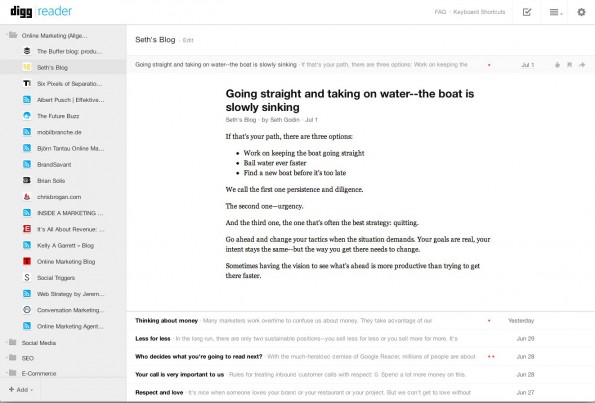
Die Arbeit am Digg Reader startete nach der Ankündigung Googles, den Google Reader einzustellen. In Anbetracht der kurzen Entwicklungszeit hat das Entwicklerteam sehr ordentliche Arbeit geleistet: die Beta-Phase des Digg Reader startete am Mittwoch, den 26. Juni, am Donnerstag, den 27. Juni, wurde der Dienst in die aktuelle iOS-App von Digg integriert. Eine Android-App ist laut Unternehmensangaben in Arbeit und soll noch im Juli 2013 erscheinen.
Dass Nutzer ihre RSS-Abonnements auch mobil abrufen können, ist ein großer Vorteil des Digg Reader. Darüber hinaus besticht der RSS-Reader durch ein ordentliches und aufgeräumtes Design. Mit einer Reihe von Keyboard Shortcuts können Nutzer schnell durch unzählige Nachrichten navigieren. Auch Twitter und Facebook sind nur einen Mausklick entfernt. Der Digg Reader zählt damit definitiv zu den besseren Google-Reader-Alternativen.
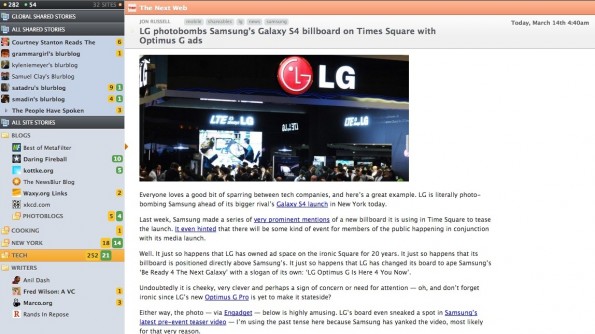
Wer keine optischen Leckerbissen erwartet, kann sich womöglich mit NewsBlur anfreunden. Die Google-Reader-Alternative stellt die Artikel selbst in den Vordergrund und eignet sich dadurch zum schnellen Überblicken der Newslage. Auch die zahlreichen Shortcuts, mit denen sich die gesamte Benutzung steuern lässt, sind ungemein praktisch. Zudem verfügt NewsBlur über intelligente Filter, die „Newsjunkies“ über Bewertungen der Artikel trainieren können. Einziger Wermutstropfen: In der kostenlosen Standardversion können Nutzer lediglich 64 Feeds abonnieren. Wer mehr will, muss für den Premium-Account einen US-Dollar pro Monat zahlen.

Good Noows gehört zu den vielseitigen Alternativen des Google Reader. Der Webdienst sortiert populäre Quellen nach Kategorien, die Nutzer ohne ein fixes Abonnement einsehen können. Sobald eigene RSS-Feeds importiert wurden, serviert Good Noows eine bunte Mischung aus Artikeln der persönlichen und allgemeinen Quellen. Dies verschafft Nutzern einen guten Überblick über die aktuelle News-Lage, ohne dass eigene Spezialgebiete vernachlässigt werden. Die Artikel lassen sich hierbei nach Populariät und Aktualität ordnen, zum späteren Lesen ablegen und über soziale Netzwerke teilen. Besonders schön sind außerdem die Anpassungsmöglichkeiten: Nicht weniger als zehn verschiedene Darstellungen der RSS-Feeds bietet die Google-Reader-Alternative.
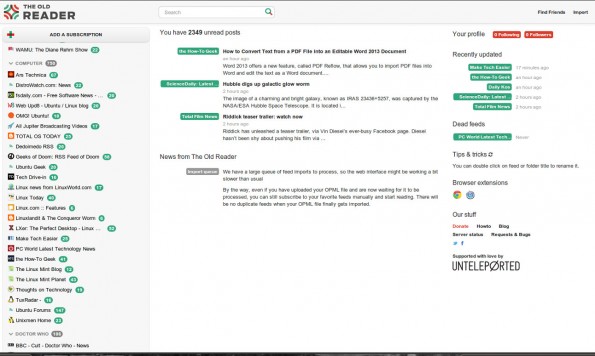
Der RSS-Reader „The Old Reader“ orientiert sich mit seinem schlichten aber funktionalen Design am alten Google Reader. In diesem Sinne ermöglicht er auch soziale Funktionalitäten: Besonders interessante Artikel können Nutzer per Mausklick in den Ordner „Shared“ befördern und damit all ihren Followern zugänglich machen. The Old Reader befindet sich derzeit noch in der Beta-Phase, scheint aber schon voll funktionstüchtig zu sein. Der Import von RSS-Feeds des Google Reader ist ohne Probleme möglich.
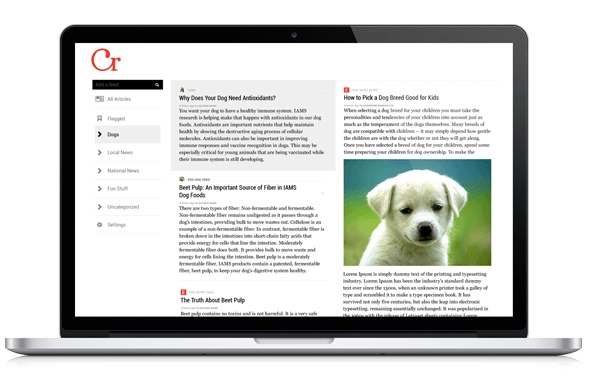
Der Curata Reader präsentiert sich als minimalistische RSS-Alternative. Er baut auf Responsive Webdesign und lässt sich damit unproblematisch auch auf Smartphones und Tablets nutzen. Eine praktische Filterfunktion ermöglicht Nutzern darüber hinaus, je nach Belieben einzelne Themengebiete hervorzuheben oder auszusortieren. Kleinere Probleme bereitet vielen Nutzern die Import-Funktion alter RSS-Feeds. Im Großen und Ganzen macht die Google-Reader-Alternative aber einen guten Eindruck, schreibt Kollege Johannes Schuba.
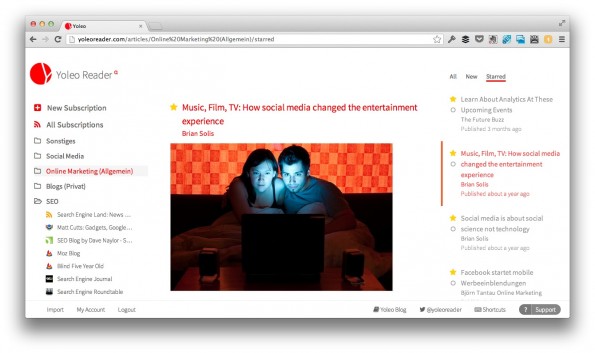
Der RSS-Reader Yoleo ist weitgehend unbekannt. Sein schlichtes und aufgeräumtes Design sowie die gute User Eperience machen ihn jedoch zu einem klaren Geheimtipp. Die Entwicklung von Yoleo startete erst nach der Ankündigung Googles, dennoch: Schon jetzt bietet der RSS-Reader alle grundlegenden Funktionen – inklusive passender Shortcuts zum schnellen Navigieren. Wer sich mit seinem Google-Konto anmeldet, kann alte RSS-Feeds per Mausklick importieren. Die Nutzung von Yoleo ist kostenlos, auf der Startseite bittet das Entwickler-Team bei Gefallen jedoch um eine Spende in Höhe von 9 US-Dollar pro Jahr.

Auch AOL lässt sich diese Chance nicht nehmen: Am vergangenen Montag veröffentlichte das US-Unternehmen eine eigene RSS-Lösung unter dem Namen AOL Reader. Vorerst nur als geschlossene Beta-Version im Web erhältlich, soll der AOL Reader alsbald auch um iOS- und Android-Apps ergänzt werden. Über eine API können außerdem auch externe Dienste auf den Lesedienst zugreifen. Gizmodo schreibt: „Alles in allem scheint er ein respektabler, leichter Reader – allerdings ohne irgendwelche Alleinstellungsmerkmale.“

Mit Feedreader ergänzen wir diese Liste um eine Alternative, die sich optisch stark am alten Windows-Look orientiert. Der RSS-Reader bietet eine Online- und eine Desktop-Version, letztere ist aber nur für Windows-Nutzer verfügbar. Das simple Layout will mir persönlich nicht gefallen, ist aber ganz auf Nachrichten-Konsum ausgelegt und insofern durchaus für Blogger und Journalisten geeignet.

Etwas schicker präsentiert sich der RSS-Reader NetNewsWire, der mit Applikationen für Mac, iPad und iPhone auftrumpfen kann. Er funktioniert als Erweiterung des Google Reader und als Einzellösung. Die Finanzierung erfolgt über Werbeeinblendungen, die Nutzer durch den Kauf einer Lizenz zum Preis von 14,95 US-Dollar entfernen können. Die Integration mit Instapaper ermöglicht das Später-Lesen einzelner Artikel. Twitter-Nutzer können über die Applikation Artikel mit ihren Followern teilen.
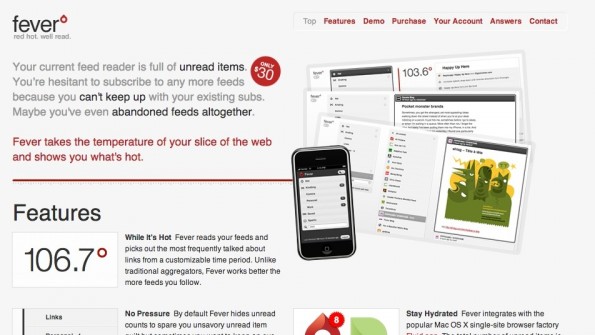
Wer über einen eigenen Server verfügt, kann neben den zuvor genannten Diensten auch Fever nutzen. Die PHP- und MySQL-Applikation bietet zum einmaligen Kaufpreis von 30 US-Dollar einen guten Überblick – auch bei mehreren hundert abonnierten RSS-Feeds. Sie ermittelt bei Bedarf automatisch welche Artikel und Themen besonders relevant sind und reduziert die Auswahl dadurch aufs Wesentliche.
Etwas anders als klassische RSS-Reader und Feedly nicht ganz unähnlich funktionieren News-Aggregatoren wie Flipboard, Pulse oder Zite. Sie kombinieren in der Regel mehrere News-Quellen – darunter auch soziale Netzwerke – und zeichnen sich durch ein magazinartiges Layout aus. Eine gute Übersicht über die verschiedenen Anbieter liefert unser Artikel mit dem Titel „28 News-Aggregatoren gegen die Informationsflut“.
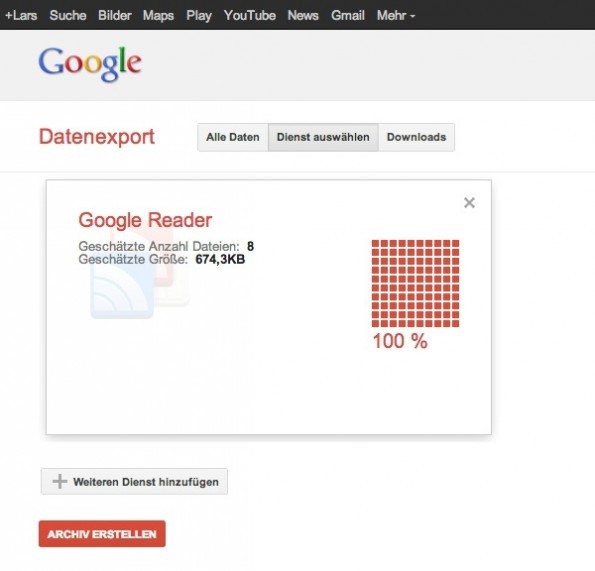
Bei nahezu allen Alternatividensten können Nutzer alte RSS-Feeds importieren. Google wiederum gestaltet den Export verhältnismäßig einfach. So erklären die US-Amerikaner im Support-Bereich, dass sich alle Reader-Daten über „Google Datenexport“ sichern lassen. In meinem Fall liegt die Größe der ZIP-Datei bei rund 680 KB. Der Download geht dementsprechend zügig vonstatten.Wer mehrere Alternativen ausprobieren möchte, tut gut daran im Vorfeld ungewünschte RSS-Feeds auszusortieren.
Letztes Update des Artikels: 01.07.2013